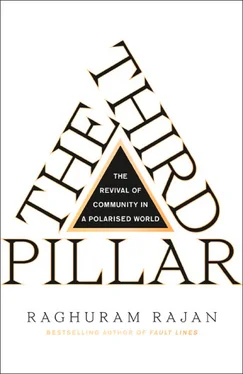Debt is thus an arm’s-length exchange of money for interest, untrammelled by the need to maintain social ties. This can draw in lenders from outside the community. In fact, such lenders may be the best at getting repaid because they will not sympathise with a borrower who has fallen on hard times, unlike a lender from within the community. Shylock, who hated Antonio, Shakespeare’s merchant of Venice, was, in a sense, the ideal lender, since he was perfectly willing to take his pound of Antonio’s flesh if Antonio did not repay the debt. Because Antonio then had every incentive to repay, Shylock was willing to lend.
These attributes of debt – that it is explicit, often secured by collateral, and impersonal – seem to favour the lender. They also make it much easier, though, for a potential borrower to get a loan at a low interest rate in competitive environments – somewhat paradoxically, the harsher the debt contract and the more it seems weighted in favour of the lender, the greater and broader the borrower’s access to finance. If, in contrast, sympathetic courts were to suspend the lender’s power to recover whenever the borrower was in difficulty, lenders would not be eager to lend to anyone who was even moderately risky, and lending would dry up. The few loans that would still be made to risky borrowers would be at sky-high interest rates. So it is from the very harshness of the debt contract, and the lender’s ability and willingness to enforce it, that the borrower gets easy access to funds. None of this is to say that borrowing is appropriate for everyone who wants money, or that debt forgiveness is bad, only that the debt contract is fit for its purpose.
In the relationships we have discussed so far, one member of the community does a favour to another without the expectation she will be repaid in full measure. In the typical debt contract, the terms including the interest rate are calculated so that both sides are satisfied if the contract is adhered to, even if they never see each other again. A relationship leaves possibilities open-ended; the debt contract calculates them to closure. A relationship requires parties to have some empathy for each other or some sense they are part of a larger, longer-term whole; the debt contract is entirely self-contained. It is in these senses that the debt contract represents the quintessential individualistic arm’s-length market transaction.
Despite the usefulness of debt, lending for interest, otherwise known as usury, has been proscribed by many religions and cultures. Usury laws capping interest rates prevent the equalisation of benefits to both borrower and lender. The lender gets less than what he might obtain in a free market. Why did such laws emerge?
THE PROHIBITION ON USURY
Societies have often prohibited lending at more than a specified moderate rate of interest. The Arthashastra, attributed to Indian Emperor Chandragupta Maurya’s adviser, Kautilya, and written around 300 BCE, has detailed prescriptions on the maximum rate of interest that can be charged for different kinds of loans. The ceiling was 1 1/4 per cent per month or 15 per cent per year for ordinary loans to people, intended to finance consumption or emergency needs. 1It went up to 5 per cent per month for ordinary commercial loans, 10 per cent per month for riskier commercial transactions that involved travel through forests, and 20 per cent per month for trade by sea. The only exception to these limits was in regions where the king was unable to guarantee security, where judges were asked to take into account customary practices among debtors and creditors. Thus, ancient India recognised a distinction between consumption loans and loans taken to fund profitable commerce, with lower ceilings on interest charged on the former. It also saw the need for the lender to receive a higher interest rate when the commercial enterprise was riskier.
The Old Testament was much less tolerant of usury. For instance, according to Exodus 22:25, ‘If thou lend money to any of my people that is poor that dwelleth with thee: thou shalt not be hard upon them as an extortioner, nor oppress them with usuries.’ Elsewhere in the Old Testament, though, there is an exception – strangers. In Deuteronomy 23:19–20: ‘Thou shalt not lend upon usury to thy brother; usury of money, usury of victuals, usury of anything that is lent upon usury. Unto a stranger thou mayest lend upon usury; but unto thy brother thou shalt not lend upon usury.’
Is the payment of interest unjustified compensation? After all, the lender has to postpone her own use of the money – think of all those middle-aged people investing money in a debt mutual fund for their old age, which the fund then lends to firms. Postponed gratification, as well as the loss of convenience in not having the money at hand for emergencies, requires some compensation. So too does any cost of preparing the loan document, checking the borrower’s credentials, and administering the loan. The lender also takes the risk the borrower may not repay, or may repay only partially, despite all the safeguards built into debt. So she also needs compensation for the risk of default. Finally, the lender’s use for money, as well as her ability to buy goods with it when she gets repaid, may be very different from today. This is another risk she bears.
The economically defensible interest rate therefore includes the time value for money plus transactions costs for making the loan plus the compensation to the lender for the risks she takes. The final piece that is tacked on is the lender’s profit, based on how pressing the borrower’s need is and what the alternative sources of loans are. So why would the ancient Hebrews prevent lenders from getting what modern economists think is their legitimate due? The answer relates to three factors: the size of the community, the condition of the borrower, and the extent of competition between potential lenders.
THE RATIONALE FOR PROSCRIBING USURY
In biblical times in Palestine, tribes were small, people poor, and the occasional borrower needed money typically to buy food or shelter for survival. The prohibition on usury within the community essentially meant the members of the community insured one another against adversity. If one tribesman’s goats died accidentally, he could go to others who were not similarly afflicted for help while he rebuilt his herd, promising to repay the favour when his luck improved.
A prohibition on taking interest would have a number of beneficial effects here. When people are living close to the edge, they are willing to promise anything for their family’s survival. If the community is poor and only a few have resources to spare at any given time, those few would then have tremendous bargaining power over the needy. If there were no prohibition on charging exorbitant interest, a temporary setback to some members of the tribe could lead them to become permanently indebted and thus enslaved to other luckier members. Over time, the enslaved would have little reason to work, the tribe would become even more impoverished, and conflict would increase.
In contrast, though, if the charging of interest were limited or even prohibited, the better-off members would have little profitable use for surplus resources. They would be forced to help out proximate neighbours or kin with interest-free loans, thus accumulating favours they could draw on when they themselves were hit with adversity. Those on the verge of starvation would have much more use for the shekel saved in interest than the well-fed lender. 2Moreover, in a small tribe, helping close tribe members survive would also be a matter of self-interest. These would be the people one would trade and work with over time. The bonds of friendship aside, if one’s trusted associates perished in hard times, one would have to build relationships with unfamiliar others, a potentially costly endeavour. Given the tribesmen’s choice between freely given mutual help and debt bondage, with uncertainty about who would come out as master and who would be enslaved, perhaps it is not surprising that they might have chosen to prohibit the latter. In a sense, therefore, the prohibition on usury created a rent, or surplus – the interest that could not be charged – that would be shared within the community to strengthen bonds.
Читать дальше












